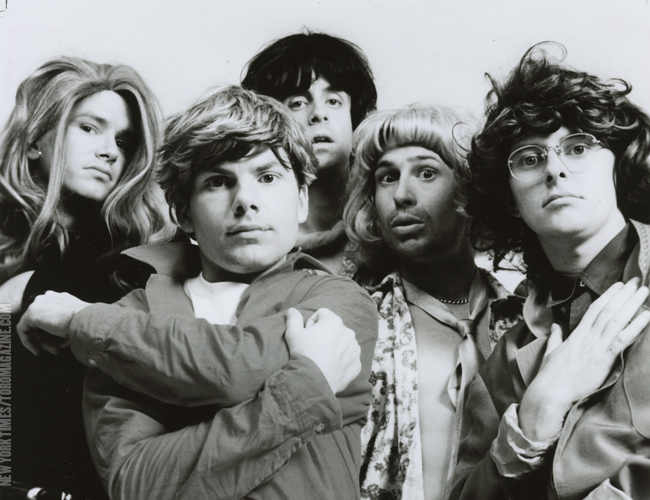Dave Foley.
Scott Thompson.
Mark McKinney.
Kevin McDonald.
Bruce McCulloch.
Every time I hear the theme song for The Kids in the Hall performed by Shadowy Men on a Shadowy planet, a smile crosses my face. Why? Because I know something absurd is about to happen thanks to these men. For five seasons, these good Canadian boys popped up on CBC to push the envelope of comedy in the most ridiculous and brilliant of ways.
And I loved every second of it.
After working in different parts of Canada together and separately for years, The Kids in the Hall finally united in Toronto in 1986 for what would become the main run of one of the most recognizable comedy troupes in Canadian history. Lorne Michaels, SNL overlord and fellow Canadian, took note. He worked with the guys to get them on CBC (88 to 94) and eventually on both CBS and HBO (89 to 95) in the USA.
Where SNL made a name for itself with topical, political comedy and celebrity impressions, The Kids in the Hall had more subversive yet in your face style that often focused on sexual identity. The guys frequently appeared in drag, though not in the “wink, wink, nudge, nudge” way most comedians did. When they dressed in drag, they were devoted to the idea of being a woman playing a role, not being a man dressed as a woman playing a role. I’ve long believed that Dave Foley looks better as a woman than he does as a man, something that actually comes up in an episode of NewsRadio.
Sexuality is also a huge component in the comedy of Kids in the Hall. While LGBT themes are prevalent throughout the run of the show, it’s not the focus nor were they making fun of the LGBT community. It’s a key component, a piece of framework. Gay characters are intended to be funny on this show, not the joke themselves. The punch line in similar sketches on other shows is the fact the character is gay.
Chappelle’s Show is quite similar in its approach to racial comedy. Stand-up comedian Dave Chappelle and company brilliantly explored racial comedy while avoiding racist comedy. Well, the first two seasons did at least. The third season, what exists of it, is all kinds of awful.
[related_content slugs=”navigating-netflix-my-name-is-earl,navigating-netflix-colombiana,navigating-netflix-hell-on-wheels,navigating-netflix-justified” description=”More Navigating Netflix” position=”right”]
Rather than doing celebrity impersonations, The Kids in the Hall frequently played themselves in sketches, sometimes fictionalized and other times pretty close to reality. This gave them a connection to the audience that others didn’t have because the watcher feels like they’re seeing the performer truly laying it out in front of them. With the number of SNL casts we’ve lived through, we know we’re watching people who are looking make the jump to the next thing. As funny as many cast members are, it’s a job, a stepping stone. There are only five Kids in the Hall, now and forever.
And Paul Bellini, of course.
Ask anyone who’s a fan of The Kids in the Hall and they’ll tell you about their favorite sketches and characters. Some people love Gavin, others Cathy and Kathie. The Chicken Lady was a fan favorite and even followed McKinney to SNL after the end of the series. I personally loved recurring sketches like Steps, Rod Torfulson’s Armada featuring Herman Menderchuk, and the prostitutes known as Maudre and Jocelyn. But when it’s all said and done, no one tops Buddy Cole.
Featuring Scott Thompson, the Buddy Cole sketches were primarily monologues set in the titular character’s gay bar. Buddy is a highly effeminate, though strong willed and forceful, socialite who loves going on long, winding rants about the gay community, celebrities and his life. Often all three things are thoroughly intertwined. He’s quick witted and engaging, like a modern caricature of Oscar Wilde. It’s safe to say that Buddy is another fan favorite.
The show ended at the right time, avoiding the slow death of becoming a stale, tired version of itself and has lived on as a cult classic series. Subsequent films, reunion tours and TV series have kept the myth alive, though nothing compares to The Kids in that Hall as they appeared on my TV screen when the pilot first aired on CBC in 1988. There’s a magic in this series that you can find in only a handful of sketch comedy series, like Mr. Show, Chappelle’s Show, Monty Python’s Flying Circus and specific seasons of SNL.
If you’ve never seen The Kids in the Hall, all five seasons are currently available on Netflix. You’ve got no excuse left.
–
Ian Goodwillie is a columnist for the Spectator Tribune. Follow him on Twitter at @ThePrairieGeek and on Tumblr at iangoodwillie.tumblr.com.
